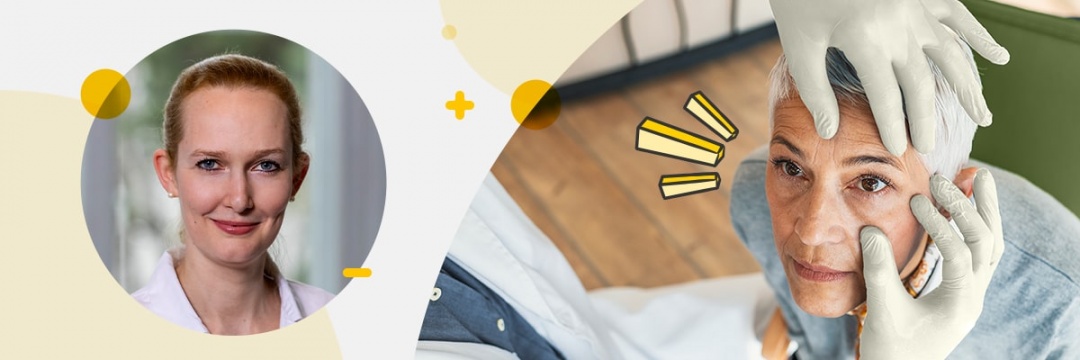Diabetes is not only about numbers. Your eyes also need a little extra care and regular checkups should be part of your diabetes management. We spoke to Ophthalmologist & Retina Specialist Dr. Bianca Gerendas about diabetes and eye health.
Do you feel that people living with diabetes are (being) educated enough on eye health when they come to your practice, or is a diagnosis often a big surprise to patients?
There are many possibilities for diabetes patients to educate themselves about eye health, but the major problem we face as eye doctors is that these patients have so many appointments with doctors and so many checks, the eyes are often neglected until people start to experience poor vision or bleeding in their eye.
This is often a late disease stage and yes, this surprises the patients. "My eyes have always been good," but suddenly they are worse. The difficulty about diabetic retinopathy is that early stages can only be seen by us as ophthalmologists. The patients don't feel the disease until later stages. The best "treatment" for the eyes is to have a well-controlled blood sugar level without large ups and downs during the day, even though it is also not a guarantee for not developing a diabatic retinopathy.
Unfortunately, this is not always possible and diabetic retinopathy can be the result. In the first stages, no treatment is necessary but more regular check-ups are required in order to catch the moment when treatment should be carried out.
Also, the awareness of patients is different when they know that they have pathological changes in their eyes already. This is often a motivation for them to manage their diabetes even better. But to get back to the question, I think education in the context of everyday situations would help. Unfortunately, the right sort of education is often unavailable which can lead to diagnostic surprises in many cases.
How do your patients typically deal with a diagnosis? Is there a difference between Type 1 and Type 2 patients?
I would say the education about diabetic retinopathy is often better in Type 1 patients and they are therefore not all too surprised.
Many Type 2 diabetes patients have lived for many years without knowing they have diabetes. Where I work, I see a lot of Type 2 cases where patients are diagnosed with diabetes one day, and the next someone tells them their kidneys aren't working well, and then I tell them they are at risk of losing their ability to see. This is a lot to deal with at once. Every patient is different, of course, and I cannot say that Type 1 or Type 2 in general accept their diagnosis better or worse.
Diabetic eye diseases often go undetected and symptom-free at first. Which regular examinations -and at what intervals -would you recommend?
The international consensus is that diabetes patients, no matter which type, should see an ophthalmologist at least once per year. With Type 1, it is ok to wait a few years with the first check up (e.g. AAO best practice pattern guidelines 2019 for diabetic retinopathy: 5 years after diagnosis) but in Type 2, an immediate check after diagnosis is necessary.
When no or only so-called mild changes are evident, a yearly check up is enough. As soon as later stages are diagnosed, the interval for check ups can range between 4 weeks and 6 months. The regular check includes a fundoscopy (a look by an ophthalmologist with a magnifying glass into the eye after pupil dilation) or, depending on the country, this may be replaced by a photograph of your retina (with dilated or undilated pupils) that is later evaluated by an ophthalmologist or someone trained to find signs of diabetic retinopathy.
There are also automated systems that work with artificial intelligence to screen patients for signs of diabetic retinopathy, mostly in symptom-free patients, and in many cases without pupil dilation. In addition to fundoscopy/photographs/automated screening, if the retina shows a swelling with fluid in or under the retina (diabetic macular edema), an examination with an optical coherence tomography system is necessary. While all of the above focuses on diabetic retinopathy, we shouldn't forget that a yearly check at an ophthalmologist is recommended for everyone as other diseases, such as refractive errors or glaucoma, could also potentially be found.
Is it common during an eye examination that diabetes is diagnosed in the first place?
There are cases where diabetic retinopathy is diagnosed before diabetes is diagnosed, but in most cases it is the other way around.
How, in your opinion, can diabetic complications in the eyes be avoided?
Every diabetes patient should start by attending annual eye checks and later, increasing the checks according to the recommended intervals. Even if "all feels well" and the patient is symptom-free, they could avoid the later stages that can lead to vision loss.
In addition to the regular examinations, are there other means of recognizing any changes at an early stage, such as apps?
I am open to automated screening systems with an endocrinologist or general practitioner, but I am not in favor of apps that are not developed and validated with the knowledge of an ophthalmologist. In general, many apps test vision which - as I mentioned earlier - is only affected in a late stage of diabetic retinopathy. If such an app tells you your vision is fine, this may give the wrong impression that your eyes are ok and you don't need to see a doctor.
This is not the case. So before you trust an app, question who developed it, how it is working, and if it really tests what needs to be tested. I am sure there will be automated tools with mobile devices in the very near future that can support doctors for screening and diagnosis, but this is not yet broadly available.
Is therapy possible? What does it look like? Have the therapy options changed over the years? If yes, how?
In general, there are 4 different therapeutic options for prevention and treatment of diabetic retinopathy: diabetes control, laser treatment, drugs applied into the eye (intravitreal treatment) and surgery. Diabetes control is the most important therapy. It has been shown in many studies that well-controlled diabetes leads less often to diabetic retinopathy, especially to late stages.
For mild to moderate retinopathy, systemic control is the only treatment option available. For later stages, namely severe and proliferative diabetic retinopathy (the more advanced form of diabetic retinopathy), laser treatment of the retina should be performed. It is the standard treatment for proliferative diabetic retinopathy and should be considered for the second eye as well in case proliferations were present in the first eye. Laser treatment has lifelong lasting results, and once completed, the disease is controlled in most cases.
If left untreated, this can lead to bleeding which, in some cases, means a surgery called vitrectomy is necessary. If proliferative retinopathy is not treated for a long time, this can lead to a tractional retinal detachment that also needs to be treated with surgery, and in many cases, cannot be treated without permanent vision loss at such a late stage. Patients maintain their vision well until late stages, which makes it all the more important to diagnose early proliferations and perform laser early to avoid bleeding, tractions, and in the worst case, tractional detachments (this is when scar tissue or other tissue grows on your retina and pulls it away from the layer underneath).
In other patients, diabetic macular edema (fluid in and under the retina, retinal swelling) needs to be treated. For the last 10 years, the standard treatment for this has been intravitreal injections with different drugs to dry out the retina. Depending on the swelling location (central or not central), vision can be affected or not.
If affected, treatment needs to be started as soon as possible and can be applied as often as once per month to maintain vision. In many cases, many injections are needed in the early stages of treatment but can be reduced or stopped after the first years. These drugs have also been shown to have a positive effect on diabetic retinopathy. In some cases, intravitreal injections may thus be an alternative to laser treatment in diabetic retinopathy but this must be discussed on a case-by-case basis.
Changes to the eye are a shock for many people with diabetes and often fraught with guilt. How do you support these patients?
I don't think this differs from other diseases. Whenever you are diagnosed with something you may have "realized" earlier, self-reproach or guilt can be a consequence. I think the most important step here is to always remember that in most cases, there are good therapeutic options available. Instead of worrying and wondering "what if," patients must think about the future, go to the checkups advised by their doctor, and try to systematically control their diabetes as best as possible.
----------------------------------------------------------------------------------------------------------
(Portrait picture in header: private)
The mySugr website does not provide medical or legal advice. mySugr blog articles are not scientific articles, but intended for informational purposes only.
Medical or nutritional information on the mySugr website is not intended to replace professional medical advice, diagnosis or treatment. Always consult a physician or health care provider with any questions you may have regarding a medical condition.





